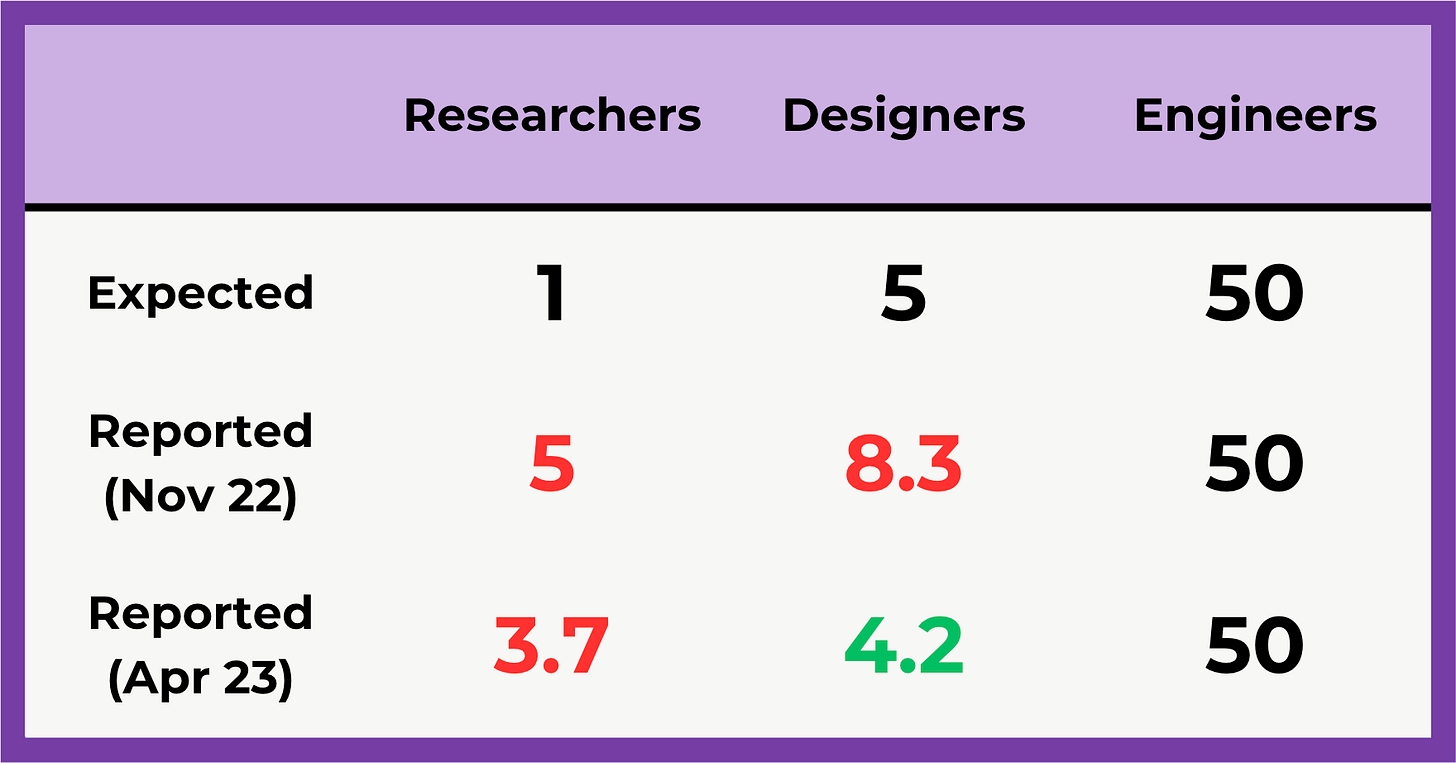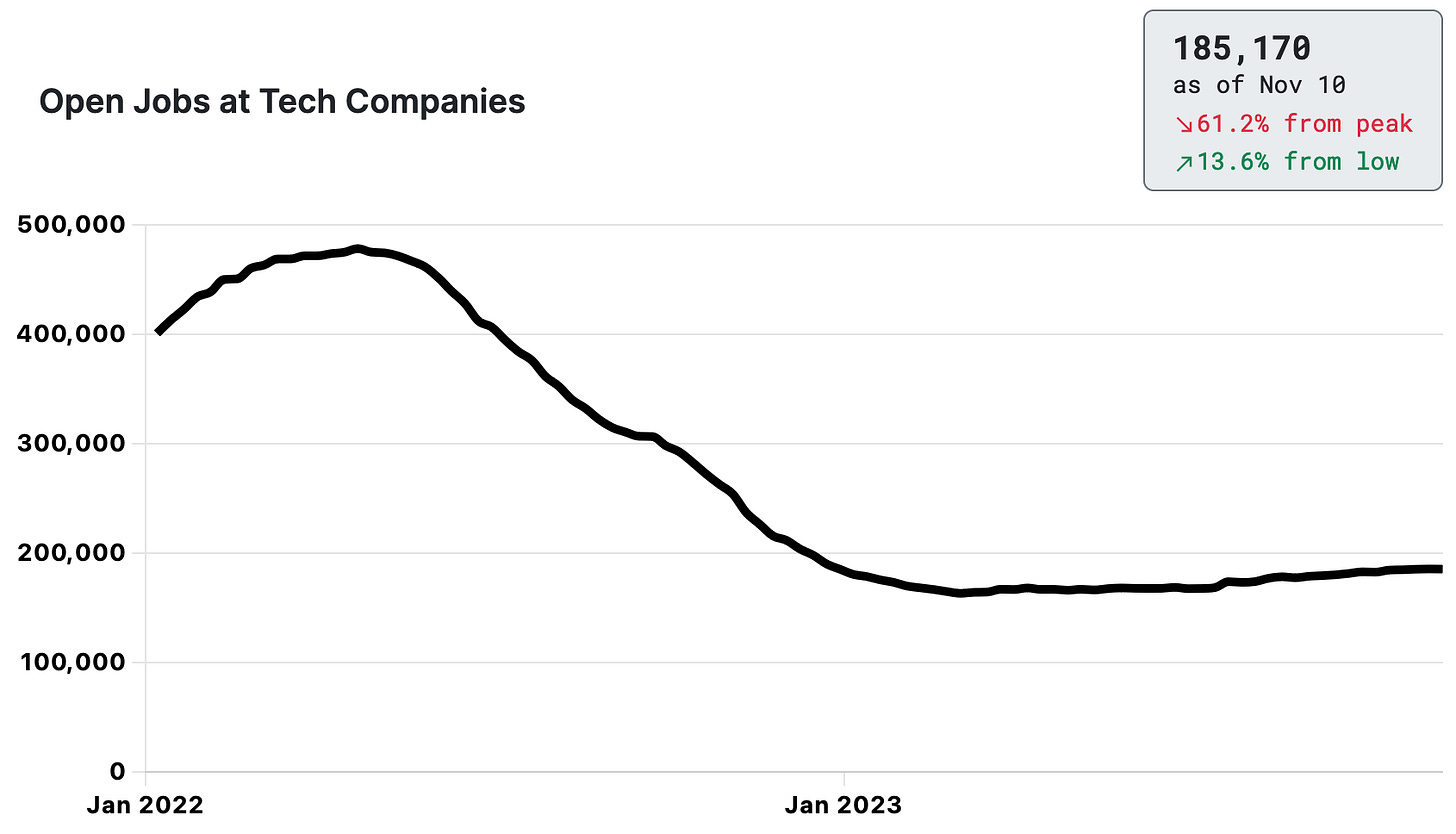UX in flux: what lead to the layoffs and what lies ahead
Answers to questions from readers about the present and future of our economy and discipline
Is the UX party officially over?
A year ago, I found some evidence that UX — and UX Research, in particular — may have been disproportionately impacted by layoffs. Since then, many companies have had further reductions in force. It’s fair to say that most UX professionals have either been personally affected or know colleagues who have.
It’s a discouraging time. Many of us are looking for direction and explanations. Some of you have even reached out to me hoping to find some clarity. I’ll be the first to admit that I don’t have all the answers, but I’ve continued collecting data on the state of the field. For whatever it’s worth, here’s my perspective on several questions I’ve gotten since last year.
Have you updated your UX layoffs data? How have the findings changed?
In November 2022, I used layoff support directories as a primary source of data. Though convenient, these public spreadsheets suffer from two major drawbacks:
Participation was voluntary and thus self-reported, creating potential sampling bias. In other words, some groups may be more or less likely to enter their information, creating an illusion of how well represented they are.
Such directories have since grown less popular. Malicious actors have abused them as a source of personal information. Plus, increased awareness of the tight job market makes their purpose less clear.
I’ve since tried to replicate those findings using public records submitted by companies in compliance with employment laws. Under many circumstances, companies are required to release detailed information about planned layoffs or else face legal scrutiny. I updated my analysis using data collected by WARN Tracker, a service that tracks and compiles these records.
Comparing these data to team size and ratio benchmarks from Nielsen Norman Group, I again found that more Researchers were laid off than expected. Instead of 1 Researcher to every 5 Designers, as in my 2022 data findings, it was closer to a 1:1 ratio. On the bright side, nominally fewer Designers were laid off than expected — about 1 for every 12 Engineers, rather than the previous 1:10 ratio.

Although these data are an improvement over self-reported stats, they have their own limitations. They’re somewhat dated, ending in April — though the size and frequency of layoffs have stabilized since then. They’re also largely limited to employees laid off in California, which may not represent the entire market of UX professionals despite being a key location for many.
Nevertheless, both sets of data suggest that UX Research may have been disproportionately affected by layoff decisions.
Has the job market for UX Research picked back up yet?
Jobs plummeted across tech in 2022, and have remained low all year.

My own data on UX Research role inventory specifically shows a similarly dramatic dropoff from all-time highs in February 2022.

The disproportionality between available UX jobs to other available Product positions is similar to what we saw in my layoffs data. That is, there are only about 70% as many open Research roles as might be expected from open Design roles. Worse, there are only 33% as many open Design roles as would be expected from open Engineering roles.
Although open UX roles are still available, they have been slower to recover than Engineering.
Why has tech taken such a huge hit?
Noted industry analyst Ben Thompson suggested that a “covid hangover” and higher interest rates are two key drivers of the tech recession.
Lockdowns and other pandemic mitigation strategies meant that customers couldn’t easily transact with businesses in-person. So the years-long gradual shift to web and mobile channels suddenly and dramatically accelerated. As restrictions loosened up and consumers returned to familiar habits, that growth rate proved to be unsustainable.

Unfortunately, many companies projected recent trends indefinitely into the future.
In the midst of all this, economic stimulus payments and low interest rates flooded the market with cash. Many businesses used this as an opportunity to scale up teams, creating a bidding war for talent. Across Big Tech, including UX Research, there was a massive hiring spree. Indeed, there’s evidence that the number of laid off employees is small compared to the new roles created.

Tech companies had staffed up and planned for a vision of a rapidly growing future that didn’t end up materializing. Inflation began to grow, consumer spending fell, and interest rates were raised in response. It becomes more difficult for organizations to justify spending for potential future rewards once large interest payments begin to accrue.
In other words, recent events helped tech to grow, but it may have grown too fast.
But why would UX Research be disproportionately impacted?
The short answer is that no one really knows.
Organizations don’t share their layoff decision making process to avoid liability and excessive scrutiny. And each layoff is in some ways an independent event with its own motivation and selection methods.
Nevertheless, people have theories. One controversial school of thought, popular on social media, says our wounds are self-inflicted: UX Research cuts can be blamed on our failure to deliver valuable insights. Though I’ve alluded to that possibility myself, it’s mere conjecture without any data to back it up.
The truth may be more complex. I previously suggested that perhaps companies hope to lean more on agencies and freelancers for UX work. It’s also possible that organizations defer to the advice of consultants whose methodologies and benchmarks may unintentionally target UX. Since there’s little data that layoffs improve company financials, it may be the case that companies imitate each other in these decisions.

Unfortunately, UX may simply be a luxury in leaner times. Engineering teams are responsible for the functionality and reliability of products — the most foundational layers in Aarron Walter’s hierarchy of user needs. As in Maslow’s hierarchy of needs, lower needs must be satisfied before the higher ones that UX is responsible for — like usability and delight — can be addressed.
In the absence of data, the simplest answer is usually best.
Should I give up on breaking into UX? Or, should I look for a job in another field?
Most people don’t have the luxury of indefinitely waiting out an economic downturn.
There are many valid reasons why one might have a greater sense of urgency, whether personal finances, or an expiring visa. It may be a practical necessity to at least temporarily pivot so that you can pay the bills and keep a roof over your head. For the time being, it might be easier to look outside of tech, since the barrier to entry will be higher for any role. But I’m far from qualified to give individual advice here.
All of that said, UX isn’t a fad. There have been professionals contributing value to organizations in this field for decades.
And there are more such professionals working today — and more open UX Researcher roles — than there were before the pandemic. Ironically, the accelerated digital transformation that has caused growing pains has also left the field stronger than it was a few years ago.
Demand for UX is there, and will eventually continue to grow.
When will things turn around?
If I could predict this with any great accuracy, I’d be managing a hedge fund, not a team of UX Researchers.
That said, there are some encouraging signs:
The US Federal Reserve may soon stop raising interest rates. That means the cost of businesses investing in themselves (e.g., by hiring) won’t continue rising so steeply.
Many Big Tech stock values are rebounding. That’s one indicator that investors are now confident that the spending excesses of the pandemic have been corrected.
There’s been a recent uptick in tech IPOs. This could show that investors have an appetite to fund growth in the tech sector.
Many companies set their financial targets and budgets for the next calendar year in the final quarter (i.e., now). If those projections are looking more rosy, it’s possible we’ll start to see more job openings when the 2024 budget opens up in January.
Hope springs eternal.
In Summary
This year hasn’t been the brightest for tech in general or UX specifically.
Many of us have lost our jobs, and many others have friends or colleagues who have been affected, or have even experienced organizational layoffs themselves. Enough readers have reached out for answers about the market that I felt compelled to share my perspective more broadly. In short:
As we saw last year, a more recent look at layoffs data from public records suggests that UX Research may have been harder hit than Design.
Open positions in tech — including UX Research — fell dramatically in 2022 and haven’t recovered in 2023, though there are still more now than before the pandemic.
Why? The tech sector grew quickly and dramatically in response to Covid restrictions and low interest rates, but has contracted somewhat since those headwinds turned direction.
No one can say for sure why UX may have been disproportionately impacted, but the simplest explanation is that engineering responsibilities like functionality and reliability are essential.
Your immediate career strategy will depend on personal factors, but the number of open roles and working UX professionals indicate a strong field that will eventually resume its growth.
It’s hard to predict when markets will turn, but a few encouraging economic indicators suggest that jobs could tick up again in the new year.
There’s nuance here, and things aren’t as dire as they might first seem, but we’re not out of the woods yet. If you’re fortunate to find yourself gainfully employed, more context on the market can help you give your work greater impact. If you’re still searching for a role, temper expectations over the coming months — but look for the opportunities that are still available. Things could turn around soon.
Though the tech and UX landscapes have been turbulent, maintaining a realistic perspective will be key to making informed decisions for your career.
Thanks to Danny Spitzberg for reviewing a draft of this article.
From the archives
ANOTHER THOUGHT…
What UX professionals should do in tough markets
I recently read an insightful essay on this topic. It begins:
“The economy stinks. Regardless of where you live in the world, you’ve probably been impacted by the current economic downturn. Most of us know people who have lost their jobs or even their homes. This is probably the worst downturn that most of us have experienced in our lifetimes.”
That was the late Tom Tullis writing in February 2009.
In times like these, it’s helpful to zoom out and recognize that our current problems, though painful, aren’t unique or unprecedented. But his essay goes a step further and offers 10 practical suggestions for professionals in our field to focus on, all of which remain relevant today.





